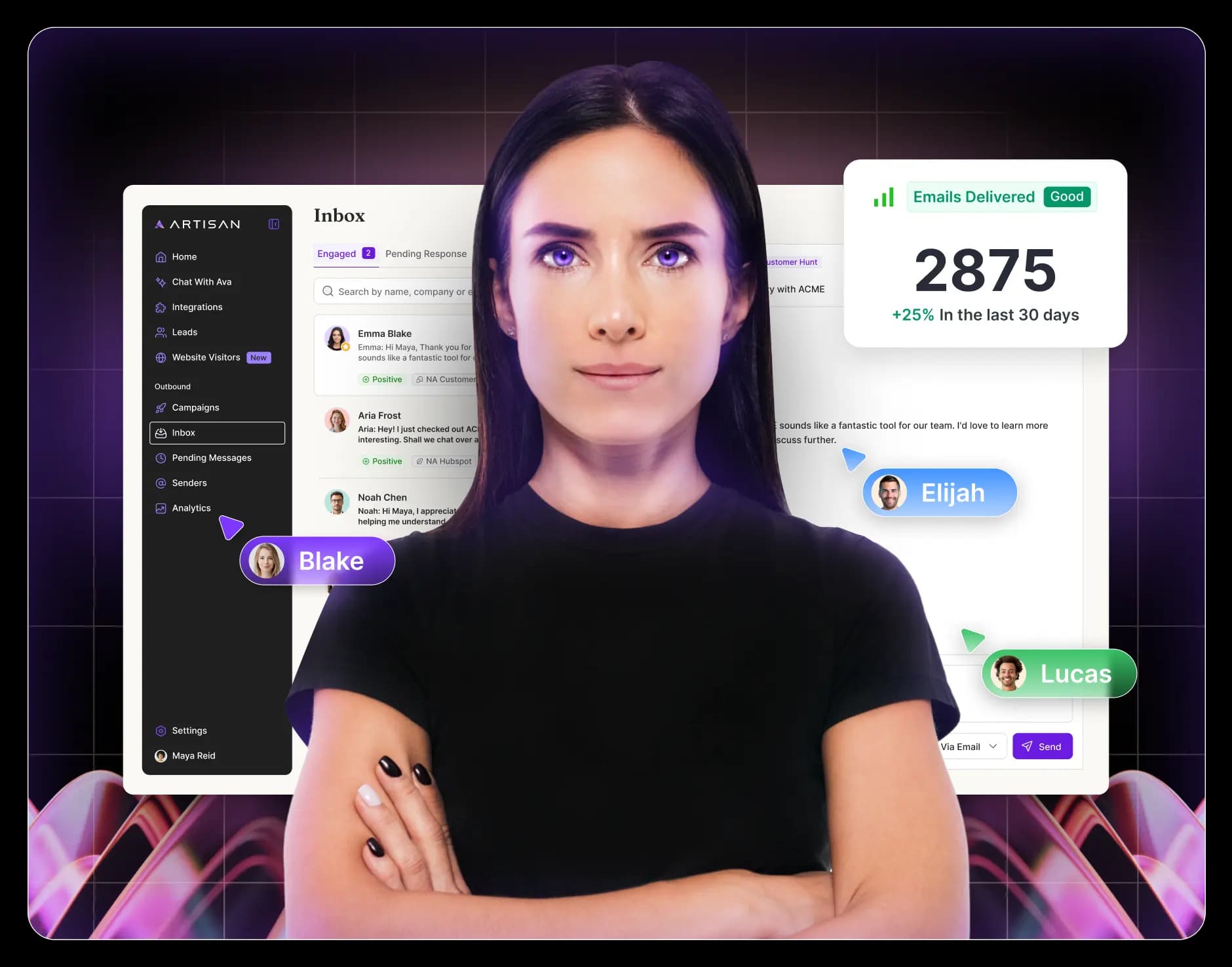From ChatGPT to Midjourney, it’s fair to say 2023 has been the year of Artificial Intelligence. While AI’s been a burgeoning trend for a while now, 2023’s massive technological leaps transformed AI from a niche interest to an investment necessary to remain competitive. We’re well beyond chatbots. Terms like “digital workers” and “the digital workforce” are now taking off.
Smart businesses are already adapting. In a recent McKinsey survey, one-third of respondents reported using generative AI regularly for at least one business function. 40% of respondents said they expect to invest more in AI in the coming years. The digital workforce is coming. Savvy businesses would be wise to hop on the bandwagon sooner rather than later.
But what exactly is a digital worker? And what separates a digital worker from your classic chatbot or smart assistant? Consider this your complete 2025 guide to digital workers to help you enter the new market poised to thrive.
What Is A Digital Worker?
A digital worker is more advanced than most AI we’re accustomed to. Previously, AI tools were mostly trained on specific functions. They might send emails, manage timesheets, or route customer inquiries. Digital workers, however, handle more complex tasks.
Digital workers are trained to automate specific roles from end-to-end. The operative word here is role. Rather than performing a single task, digital workers are specialized for entire workflows. They’re trained to perform all functions associated with a given job. Digital workers operate in a highly human fashion, sharing more similarities with the average employee than the average chatbot.
What Can Digital Workers Do?
Quite a lot! Digital workers can fill many different roles in a company. They can serve as graphic designers, HR managers, sales reps, and beyond. As technology advances, you can expect even more jobs to be filled by digital workers.
Digital workers are trained to act as colleagues. Just like a human employee, digital workers learn organically. By interacting with your customers and your team, they improve their performance based on feedback and company needs.
What Are the Benefits of Digital Workers?
Companies are already reaping massive benefits from AI and the digital workforce as a whole. A recent MIT survey of 6,049 workers across five countries showed overwhelming enthusiasm toward AI. 92% of respondents said AI made a positive impact on their work, and over a quarter of respondents called AI “a miracle.”
So, what’s all the hype about? For digital workers specifically, there are a couple of unique benefits.
Democratized Access to Labor
Digital workers are great news for startups and small businesses. Companies short on cash are often at a competitive disadvantage. They’re forced to operate with a skeleton crew, only hiring roles that are 100% vital to day-to-day operations. This leads to gaps in expertise that are hard to fill without certain niche skill sets. This is where digital workers come into play.
Digital workers are a cost-effective means to access highly skilled labor. If you’re unable to, say, foot the bill for a full-time sales rep or graphic designer, a digital worker can help. Cheaper access to sought-after skills helps businesses on all levels stay competitive, evening out the playing field considerably.
Boosts in Productivity
Digital workers don’t have brains; they have databases. Their memory is significantly better than human workers, and they can, therefore, massively boost your organization’s productivity.
There have already been multiple studies on how AI tools can impact productivity, most of which have shown an overwhelmingly positive effect. For example, three recent case studies by the Nielsen Norman Group analyzed AI’s ability to resolve customer inquiries, write business documents, and code small software projects. AI could handle 13.8% more customer inquiries per hour, write 59% more business documents per hour, and code 126% more projects per week.
These are just tools trained to perform a few specific tasks, however. Digital workers, in contrast, perform entire roles. It’s fair to expect even higher AI-related productivity boosts in the years to come as the digital workforce grows. Being an early adopter of this technology sets your company up for success.
Gaining a New Colleague
Remember, a digital worker is more than just a bot. They interact with your team, much like a real human employee, and learn new skills over time. While the most popular AI solutions on the market are one-size-fits-all models, new technology is creating more catered, individualized options. Digital workers show great promise in this regard.
Digital workers have a history of working with each employee one-on-one. They become more in tune not only with workers’ individual needs and preferences but with the culture of your business. The humanness of digital workers sets them apart from other AI. You’re not just gaining a new tool – you’re gaining a whole new colleague.
What Are The Risks of Digital Workers?
No new technology is without risks, and, unfortunately, many companies are ill-prepared to deal with potential bumps in the road. According to the aforementioned McKinsey survey, only 21% of respondents say their companies have established policies regarding the use of AI.
Risks are not necessarily a reason to avoid investing, but being underprepared for drawbacks has repercussions. Understanding risks from the get-go helps you mitigate hiccups.
Employee Fear
There’s a well-documented – and understandable! – fear of obsolescence related to AI and the encroaching digital workforce. After all, if digital workers can perform entire roles at a drastically lower cost, what’s the point of maintaining human employees at all? Rolling out digital workers too fast can cause a drop in employee morale, and may even inspire some valued employees to start sending their resumes elsewhere for fear of inevitable layoffs. This is why it is so important to introduce digital workers the right way.
Encourage employees to see digital workers as their co-pilots, not their replacements. Digital workers are not here to take jobs so much as to change them for the better.
Digital workers are an opportunity not only for more productivity but for a more enjoyable workload overall. AI can assist with tedious tasks where human error is likely, freeing up your employees’ brains for more mentally stimulating, fulfilling work. Plus, digital workers are often taking on roles that would otherwise go unfilled due to budgetary constraints. Digital employees are not stealing jobs so much as filling in existing gaps in resources.
Inaccuracies
The number one fear associated with AI is inaccuracies. ChatGPT is notorious for factual errors, something that has stymied its growth in 2023. Digital workers may have superior memory to human beings; they’re still a man-made technology. Just as our brains are fallible, so is AI.
There are two solutions here to mitigate the risk of inaccuracies.
First, remember the human touch. A digital worker’s performance should be continually monitored, evaluated, and occasionally corrected. Not only does this ensure accuracy, but it also helps solve another major risk with AI – employee fear. The fact that digital workers still rely on flesh-and-blood employees to function properly should help reduce apprehension about their implementation in the workplace.
Second, onboarding is as important for digital workers as human ones. Make sure your digital worker starts off with a strong informational base. The more AI knows about your company, its values, its operations, and its goals, the better equipped it’ll be to thrive. While you’ll still need to monitor your digital workers’ performance and thoroughly fact-check any reports or copy, a strong onboarding process greatly reduces the risk of error.
Digital Workers in 2025: The Bottom Line
AI is rapidly advancing, and digital workers are a particularly promising part of the equation. Over the next few years, we expect digital workers to become more and more human and therefore have a lot more functionality. While there are certain risks associated with any new technology, careful and responsible tech adoption helps mitigate those risks.
Going into 2025, keep a close eye on the digital workforce. With the vast majority of companies now using generative AI to streamline business processes, adaptation is key to thriving in a changing market.

